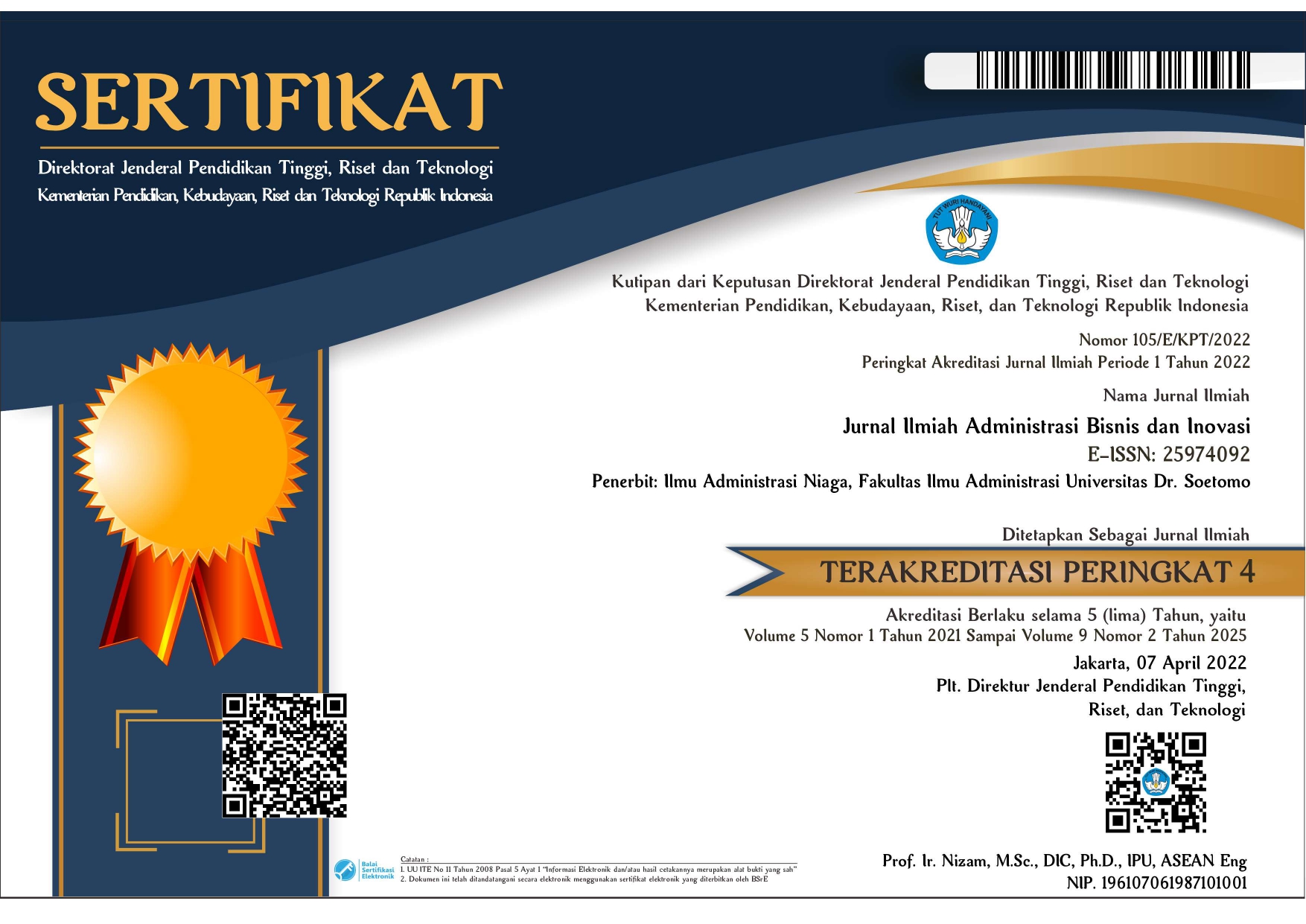Analisis Karakteristik Demografis Dan Lama Penggunaan Kosmetik Terhadap E-WOM Dan Keputusan Pembelian Merk Emina di Kota Semarang
 Abstrak views: 256
,
Abstrak views: 256
,
 Full Text (PDF) (English) downloads: 407
Full Text (PDF) (English) downloads: 407
Abstrak
Kosmetik saat ini menjadi komoditi yang sangat dibutuhkan oleh wanita yang menunjang penampilan sehari-harinya. Sebagai kebutuhan primer wanita tentunya industry kosmetik mendorong kompetisi semakin tinggi salah satunya Emina sebagai brand local kosmetik di Indonesia. Brand local tentunya tidak mudah dalam menempati posisi teratas dibanding brand impor. Dengan demikian kemampuan E WOM dalam mempengaruhi keputusan pembelian sangat penting dengan memperhatikan karakteristik demografi konsumen di Indonesia. Penelitian ini bertujuan untuk mengetahui pengaruh E WOM terhadap keputusan pembelian dengan moderasi dari karakteristik demografi dan lama penggunaan. Penelitian ini menggunakan sampel sebanyak 100 responden yang berdomisili di Semarang Jawa Tengah. Penelitian ini dilakukan dengan cara menyebarkan kuesioner secara langsung dan kuesioner dalam bentuk google form. Alat analisis yang digunakan dalam penelitian ini adalah analisis WarpPls. Hasil penelitian menunjukkan bahwa E WOM berpengaruh signifikan terhadap keputusan pembelian, lama penggunaan kosmetik memiliki pengaruh signifikan sebagai pemoderasi antara E WOM dan keputusan pembelian, karakteristik demograsi yaitu usia dan tingkat pendapatan berpengaruh tidak signifikan dalam memoderasi hubungan antara E WOM dan keputusan pembelian. Kosmetik Emina perlu mempertimbangkan peran pengalaman terbarik dari konsumen sebagai pengguna kosmetik lokal karena dengan pengalaman, konsumen dapat memberikan informasi terbaik kepada orang lain. Pengalaman ini dapat diaplikasikan dalam bentuk strategi produk dan harga yang lebih baik daripada sebelumnya.
Kata Kunci: E WOM; Karakteristik demografi; lama penggunaan kosmetik; keputusan pembelian
Referensi
Chevalier, J. and Mayzlin, D. (2006), “The effect of word-of-mouth on sales: online book reviews”, Journal of Marketing Research, Vol. 43 No. 3, pp. 345-354.
Fang, Y.H. 2014. Beyond the credibility of electronic word of mouth: Exploring E WOM adoption on social networking sites from affective and curiosity perspectives. International Journal of Electronic Commerce 18, no. 3: 67–102
Farkas, M.F., Gholampour, A., Bouzari, P., Jarghooiyan H., Ebrahimi, P,. (2021). How gender and age can affect consumer purchase behavior? Evidence from A microeconomic perspective from Hungary, D-minister Nº. 39 July - December 2021, pp. 25 - 46 · ISSN 1692-0279 · eISSN 2256-4322
Goyette et al, (2010). e-WOM Scale: Word-of-Mouth Measurement Scale for e-Services Context; Canadian Journal of Administrative Sciences. Vol.27,. Pp 5–23.
Haji, R., & Stock, W. G. (2021). User settings for advertising optimization on Facebook: Active customer participation or settings blindness? Telematics and Informatics, 59. https://doi.org/10.1016/j. tele.2020.101548
Hennig-Thurau, T., Gwinner, K.P., Walsh, G. & Gremler, D.D. (2004). Electronic word-of-mouth via consumer opinion platform: what motivates consumers to articulate themselves on the internet?. Journal of Interactive Marketing, 18, 38-52.
Jiunn-Woei Lian, D. C. (2014). Online shopping drivers and barriers for older adults: Age and gender differences. Computers in Human Behavior, 133-143.
Kotler, Philip, (2003). Manajemen Pemasaran. Edisi Kesebelas. Indeks Kelompok Gramedia. Jakarta
Kotler, P. &. (2012). Manajemen Pemasaran Jilid 1 dan 2 . Jakarta: Erlangga.
Lee, C.H. and Cranage, D.A. (2014), “Toward understanding consumer processing of negative online word-of-mouth communication: the roles of opinion consensus and organizational response strategies”, Journal of Hospitality & Tourism Research, Vol. 38 No. 3, pp. 330-360.
Lin, Chinho, Yi Shuang Wu, Jeng-Chung Victor Chen. (2013). Electronic Word of Mouth: The Moderating RolesOf Product Involvement And Brand Image. Thailand.
Sari Listyorini, R. E. (2021). The Power of Influencers as Comparative Models of Social Models in the Selection of Local Fashion Brands. ICISPE 2021 . Semarang: eudl.
Munandar. (2017). Faktor-Faktor Yang Mempengaruhi Perilaku Konsumen Dalam Membeli Kopi Espresso. Jurnal Visioner & Strategis, 6(1).
Poturak, M., Turkyilmaz, M., (2018). The Impact Of E WOM In Social Media On Consumer Purchase Decisions: A Comparative Study between Romanian and Bosnian Consumers, Management and Economics Review, Volume 3, Issue 2
Schiffman, L.G dan Kanuk, Lesley L, 2007. Consumer Behavior, New Jersey: Person Prestice Hall.
Schiffman, Leon, & Leslie Lazar Kanuk. (2008). Consumer Behaviour 7th Edition (Perilaku Konsumen). Jakarta: PT. Indeks.
Schifman, L.G & Kanuk, L. L. (2010). Consumer Behavior. New Jersey: Pearson Education, Inc.
See-To, E.W., and K.K. Ho. 2014. Value co-creation and purchase intention in social network sites: The role of electronic Word-of-Mouth and trust – a theoretical analysis. Computers in Human Behaviour 31: 182–9
Senecal, S. & Nantel, J. (2004). The influence of online product recommendations on consumers’ online choices. Journal of Retailing, 80(2), 159-169.
Sudharto P. Hadi. (2007). Perilaku Konsumen. Semarang: Badan Penerbit Universitas Diponegoro.
Wang, Y. and Yu, C. (2015), “Social interaction-based consumer decision-making model in social commerce: the role of word of mouth and observational learning”, International Journal of Information Management
Wolny, J. and Mueller, C. (2013), “Analysis of fashion consumers’ motives to engage in electronic word of mouth communication through social media platforms”, Journal of Marketing Management, Vol. 29 Nos 5/6, pp. 562-583
##submission.copyrightStatement##
##submission.license.cc.by-nc-sa4.footer##Authors who publish with Inform: JIABI: Jurnal Ilmiah Administrasi Bisnis dan Inovasi agree to the following terms:
Authors retain copyright and grant the journal right of first publication with the work simultaneously licensed under a Creative Commons Attribution License (CC BY-SA 4.0) that allows others to share the work with an acknowledgment of the work's authorship and initial publication in this journal.
Authors are able to enter into separate, additional contractual arrangements for the non-exclusive distribution of the journal's published version of the work (e.g., post it to an institutional repository or publish it in a book), with an acknowledgment of its initial publication in this journal.
Authors are permitted and encouraged to post their work online (e.g., in institutional repositories or on their website) prior to and during the submission process, as it can lead to productive exchanges, as well as earlier and greater citation of published work.









